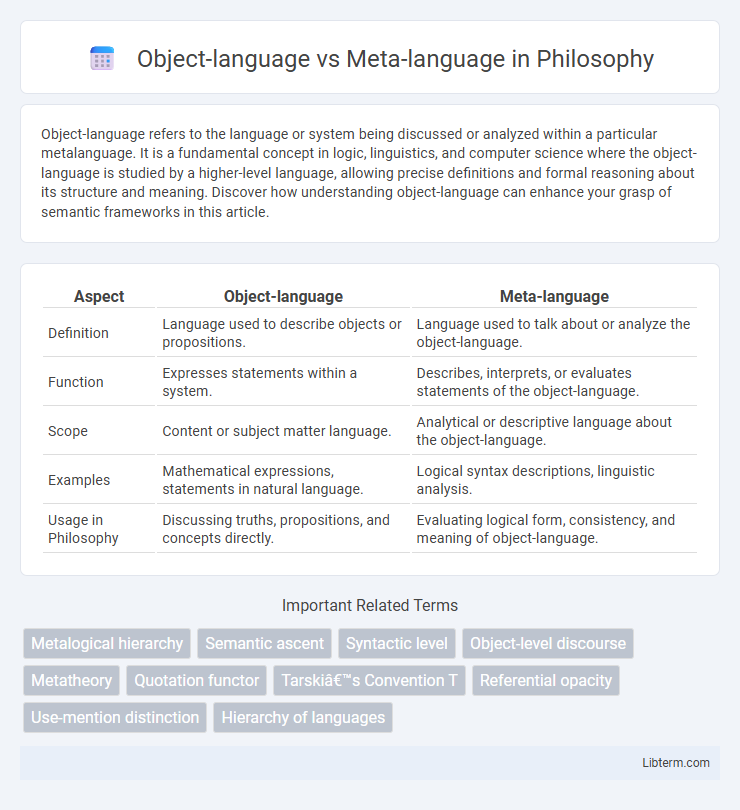Object-language refers to the language or system being discussed or analyzed within a particular metalanguage. It is a fundamental concept in logic, linguistics, and computer science where the object-language is studied by a higher-level language, allowing precise definitions and formal reasoning about its structure and meaning. Discover how understanding object-language can enhance your grasp of semantic frameworks in this article.
Table of Comparison
| Aspect | Object-language | Meta-language |
|---|---|---|
| Definition | Language used to describe objects or propositions. | Language used to talk about or analyze the object-language. |
| Function | Expresses statements within a system. | Describes, interprets, or evaluates statements of the object-language. |
| Scope | Content or subject matter language. | Analytical or descriptive language about the object-language. |
| Examples | Mathematical expressions, statements in natural language. | Logical syntax descriptions, linguistic analysis. |
| Usage in Philosophy | Discussing truths, propositions, and concepts directly. | Evaluating logical form, consistency, and meaning of object-language. |
Understanding Object-language: Definition and Purpose
Object-language refers to the language or system being studied or analyzed within a linguistic, logical, or philosophical framework. It serves as the primary language used to express statements, propositions, or theories that are subject to description or evaluation by a meta-language. The purpose of the object-language is to provide a structured means of communication and representation, enabling precise discussion and analysis of its elements within a higher-level meta-language.
Meta-language Explained: Role and Importance
Meta-language functions as the language used to describe, analyze, or interpret an object-language, providing a framework for discussing the syntax, semantics, and rules governing the object-language. Its role is crucial in fields like linguistics, logic, and computer science, where meta-languages enable precise definitions and facilitate the study of language structure and meaning. Understanding meta-language enhances the ability to create formal grammars, develop programming languages, and establish rigorous semantic models.
Key Differences Between Object-language and Meta-language
Object-language refers to the language being studied or analyzed, while meta-language is the language used to describe or discuss the object-language. Key differences include their roles; the object-language contains expressions or statements, whereas the meta-language provides tools for interpretation and evaluation of those expressions. Meta-language often features higher-level syntax and semantics to facilitate commentary on the object-language's structure and meaning.
Historical Development of Object-language and Meta-language
The historical development of object-language traces back to early formal logic, where philosophers like Gottlob Frege distinguished between language used to talk about objects and language used to talk about language itself. Meta-language emerged prominently in the 20th century through the works of logicians such as Alfred Tarski, who formalized the concept to define truth predicates and analyze semantic concepts. This distinction laid the foundation for structuralist linguistics and modern computational theories of language, influencing the evolution of semantics and syntax in both natural and formal languages.
Common Examples in Philosophy and Linguistics
Object-language refers to the language under discussion or analysis, while meta-language is the language used to talk about or describe the object-language. In philosophy, examples include Aristotle's analysis of logic where the object-language involves the statements themselves, and the meta-language encompasses logical rules discussing those statements. In linguistics, an object-language could be English sentences, whereas the meta-language consists of grammatical terminology or phonetic descriptions used to explain English.
Why Distinguishing Object-language Matters
Distinguishing object-language from meta-language is crucial because it clarifies the levels of discourse, where object-language refers to the language being discussed and meta-language is the language used to discuss or analyze the object-language. This distinction prevents ambiguity and paradoxes in logic and linguistics by maintaining a clear boundary between statements and commentary about those statements. Understanding this separation enables more precise formal analysis and prevents confusion in semantic interpretation and language theory development.
Meta-language in Formal Logic and Mathematics
Meta-language in formal logic and mathematics serves as the language used to describe, analyze, and reason about an object-language, which is the system under study. It includes special symbols, rules, and syntax that allow mathematicians and logicians to define semantics, formulate proofs, and express meta-theoretical properties of the object-language. The precision and clarity of meta-language are essential for establishing soundness, completeness, and consistency within formal systems.
Challenges in Separating Object-language from Meta-language
Distinguishing object-language from meta-language poses significant challenges due to their intertwined use in linguistic analysis and formal logic, where object-language is the language being studied, and meta-language is the language used to describe it. Ambiguities arise when statements within the meta-language refer to elements of the object-language, leading to semantic and syntactic overlap that complicates clear separation. This conflation can result in paradoxes such as the liar paradox, which highlight the difficulty in maintaining a strict boundary between the two language levels.
Applications in Computing and Programming Languages
Object-language refers to the language that is being described or manipulated, while meta-language is the language used to describe or analyze the object-language. In computing and programming, meta-languages like XML or JSON define the structure and rules for object-languages such as data formats or programming syntax. Compiler design heavily relies on meta-languages to specify grammar and semantics of object-languages, enabling automated parsing and code generation.
Future Directions: Research and Debates on Meta-language
Future research on meta-language explores its evolving role in artificial intelligence, natural language processing, and programming languages, enhancing the clarity and precision of communication between humans and machines. Debates center on developing adaptive meta-languages that can self-modify and improve semantic interpretation in real-time, addressing challenges in machine understanding and linguistic complexity. Advances in formal semantics, machine learning integration, and human-computer interaction will drive new meta-language frameworks capable of representing increasingly abstract and dynamic knowledge structures.
Object-language Infographic

 libterm.com
libterm.com